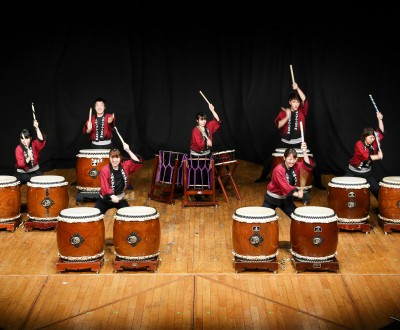Taiko
Japanese traditional drums
When we think about the sounds of Japanese festivals, one particular percussion instrument comes to mind: the taiko, a big oval drum on which players hit their sticks in a powerful manner. This instrument can rest on the floor or in a horizontal position, and the musician stands in front of it to play. The sound coming out of it is a strongly resonating bass; the rhythm changes according to the story or the event that the drum illustrates. We often hear drums in Japanese movies or dramas illustrating the beginning of a war, which was the reality in ancient Japan, as taiko were used to announce wars and show enthusiasm. We can also hear it at the start of a play or in the rhythms of diverse dances.
Origin and historical evolution
This musical instrument is traditional to Japan. Its original name was wadaiko, even if taiko is widely used now, especially outside of Japan’s borders. It has undergone several evolutions across time, both socially and musically. First used by the army, it is now an integrated part of daily life and has lost the scary aura it used to inspire. We do not know the exact date of creation, but its seems the instrument dates back to the 5th century, when its use and practice were already part of events and festivals.
We know of a mythical origin linked to Amaterasu. The original tale relays how the deity Uzume danced on a drum to get Amaterasu out of her cave, and the agitation made Amaterasu go outside. Another version tells how the first taiko was invented. This mythical moment is copied during funerals to celebrate life and mostly during matsuri that are related to ancestors, such as O-bon.
Nowadays, the taiko are not only used during festivals or traditional events. There are numerous music bands in Japan and outside the country where taiko are the main instruments. For a Westerner, a concert where taiko (even only one) are played can seem a bit long and strange. However, for a Japanese person who grew up with festivals and the sound of taiko, this kind of concert awakens memories and a smooth nostalgia that allows him or her to understand and differentiate the musical pieces.
Application
Intensity of the game happens to be crucial. Taiko musicians do not only have the role of hitting the drum with the planned rhythm. They use numerous qualities in order to make their play as alive as possible; the rhythm goes along with choreographed movements, shouting, silences, and fast beating that make it more of a show than a musical concert.
Eitetsu Hayashi is one of the most famous taiko musicians. First a member of Ondekoza band, he became famous and started a solo carrier that brought him to the United States of America. When he started to play, his training required a severe life, in order to play as intensively as was required by his mentors.
As musicians have to totally dedicate their life to playing, the band’s life looked a lot like sumo training: physical exercises and taiko practices at all times.
In the USA and UK, there are several schools teaching taiko, and we assist with some of the festivals and concerts, such as Bellevue World Taiko Festival, or the schools, such as the San Francisco Taiko Dojo or San Jose Taiko.

